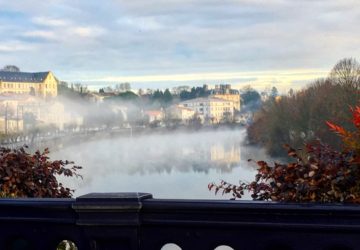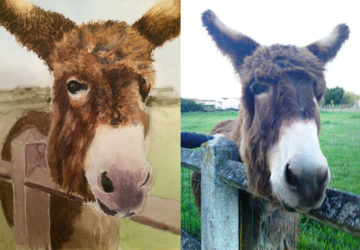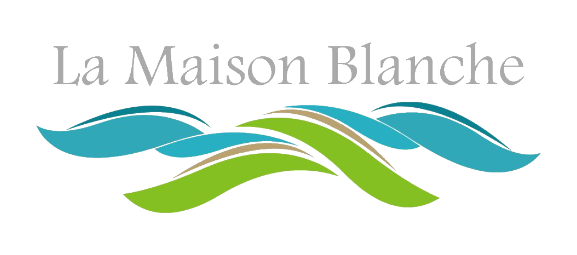The course is open to anyone and everyone, from complete beginners to experienced artists. David Johnson (well we all know him as DJ) will be offering individual guidance and tuition with personal art projects, as well as painting demonstrations for the whole group.
DJ is an international prize-winning Artist. He has been teaching Art Classes, providing painting demonstrations and running painting workshops throughout the UK and Europe for over 10 years. His style has developed through many years of experience working in professional fine art studios, and by designing and producing artwork for hotels, restaurants, commercial spaces, public areas and private estates worldwide.
DJ has been a finalist and published in the ‘International Artist’ magazine 4 times so far and he has been shortlisted 3 times for the ‘Artist of the Year’ award run by the “Artists and Illustrators’ magazine”. He has had his work on show in the Mall Galleries in London and in 2016 he won the ‘Wild & Tame’ art prize at the ‘Artist of the Year’ awards in London. This year he won the ‘Peoples Choice Award’ at the Leamington Spa Museum and Art Gallery, Biennial Exhibition. And as if that wasn’t enough DJ is also a thoroughly nice guy and lots of laughs too.
This is one of DJ’s oil paintings called SILVER BIRCH

Excerpt from “Into the Wild” – International Artist
Adventuring into the mountains allows DJ the chance to experience the landscape firsthand
Spending time with nature has always been a huge source of inspiration, and the mountain environment holds a special fascination for me. I love scrambling up high to seek out rocky crags and elevated views of the valleys below. Painting outdoors is simply the best way to really immerse yourself in a landscape and connect with your subject. “Being there,” I find, is the most effective way to experience the natural colour, light and tonal values of a given landscape, as well as being able to witness the day as it evolves, capturing the true essence of the moment. I also find it much easier for me to get “in the zone” and totally focus on my painting. Mountainous areas have their own weather systems that can provide you with all four seasons in one day, and as the artist, you can select elements of these moments to add to your painting. The painting then becomes a story of the whole day, rather than a quick snapshot.
Read moreMy favourite season for painting mountains is winter. When the hills are cloaked in a blanket of snow, it completely transforms the landscape. Many of the crags and broken ridges have been sculpted with blizzard blown cornices or shrouded in veils of ice. This helps to define the individual shape, form and character of each mountain. Frost and snow reflect the colour of the skies, and the shadows change from strong, bold, dark tones to subtle shades of blues and purples. If you are lucky enough to catch a winter sunset or sunrise, you will witness the hills painted in shades of pinks, yellows, reds, lilacs and blues that can be so intense as to look otherworldly for a short while.
Mountaineering and rock climbing have been my favourite outdoor activity since childhood, so combining these with my lifelong passion for painting was a natural progression. My years of experience in the mountains have provided me with necessary skills essential for my own safety in these sometimes-extreme environments, while I’m trying to capture the essence of the landscape onto canvas from these lofty viewpoints.
If you have little or no experience of mountaineering then I would strongly advise getting out there and walking in the mountains before you paint them. This will help give you some essential experience and respect for the environment as well as valuable time spent getting to know your subject. Winter mountaineering is a different ball game, and enrolling on a winter mountaineering skills course would be essential to stay safe. If trekking in this environment isn’t possible, there are many areas in the mountains where younneed only go for a short walk from your car to set up an easel and paint.
My project for this demonstration began with an outdoor painting adventure high up in the mountains of Snowdonia in North Wales. Taking a path from the Llanberis Pass I climbed up high and onto Crib Goch, a legendary knife-edge arête and part of the Snowdon Horseshoe. With a full winter mountaineering kit and a full painting kit I scrambled along the crest until I found a perfect studio spot near the end of the ridge approximately 900 metres above sea level. I carry all of my own equipment that includes a pochade box full of paints, brushes and painting boards, a tripod, camera, rags and brush washers. When I’m in the mountains in winter conditions I will also have a rucksack full of a “winter kit” including crampons and ice axe. It can sometimes take up to three hours to climb to a painting spot so I have to be prepared.
After lashing my tripod to a boulder to prevent it from taking flight in the gusts, I began by laying down some colours and textures onto the canvas board using brushes, palette knives and some very cold fingers. I spent about 90 minutes painting the scene before me and taking photos, all the time absorbing the breathtaking scenery until the weather suddenly began to deteriorate. As the sun dipped behind Snowdon I could clearly hear the wind howling up the valley from Llanberis, which then began to lift my easel and the boulder which it was tied to! I quickly packed up my kit and scrambled along the Crib Goch ridge down to the relative refuge of a col to weigh up my options. As the mountainside below me wasn’t too steep I decided to adopt a controlled slide down to the Pyg Track path below, and use my ice axe to regulate my bumpy ride! The pochade box was bounced and rattled around on my descent, so you can imagine my surprise when I eventually reached the path to see that my box and painting were miraculously intact.
Back in the studio I took a 3-by-4-foot canvas and applied three layers of gesso lightly sanded between coats. My source materials for this piece were the plein air study as reference for colour, tone and light, and my photos for composition and detail. You can see from the photos, the colour and light are noticeably different in the plein air study when you compare it with the photo taken from the same ridge. A good example of how painting studies of your subject outdoors can provide you with valuable information and guidance.
The photo I chose to use for the composition had an interesting mixed foreground of rocky pinnacles, snow and grasses. This prospect laid the foundations for the iconic shape of Crib Goch Ridge on the left, leading onto Carnedd Ugain on the right and finally left to the distinctive summit of Snowdon. This vista provided me with a visually stimulating layout that guides the eye around the painting. The mixed ground of rock and snow covering the flanks and peaks of the mountains gave me plenty of opportunity to play around with a palette knife, applying paint expressively. This can vary from thick and smooth like ice cream to delicate broken stippled patterns similar to those found in stone and scrub. These techniques are especially relevant to mountain landscapes where sharp edges, smooth surfaces and broken textures are all around.
[Into the Wild – International Artist magazine – pg. 54 – 57]





